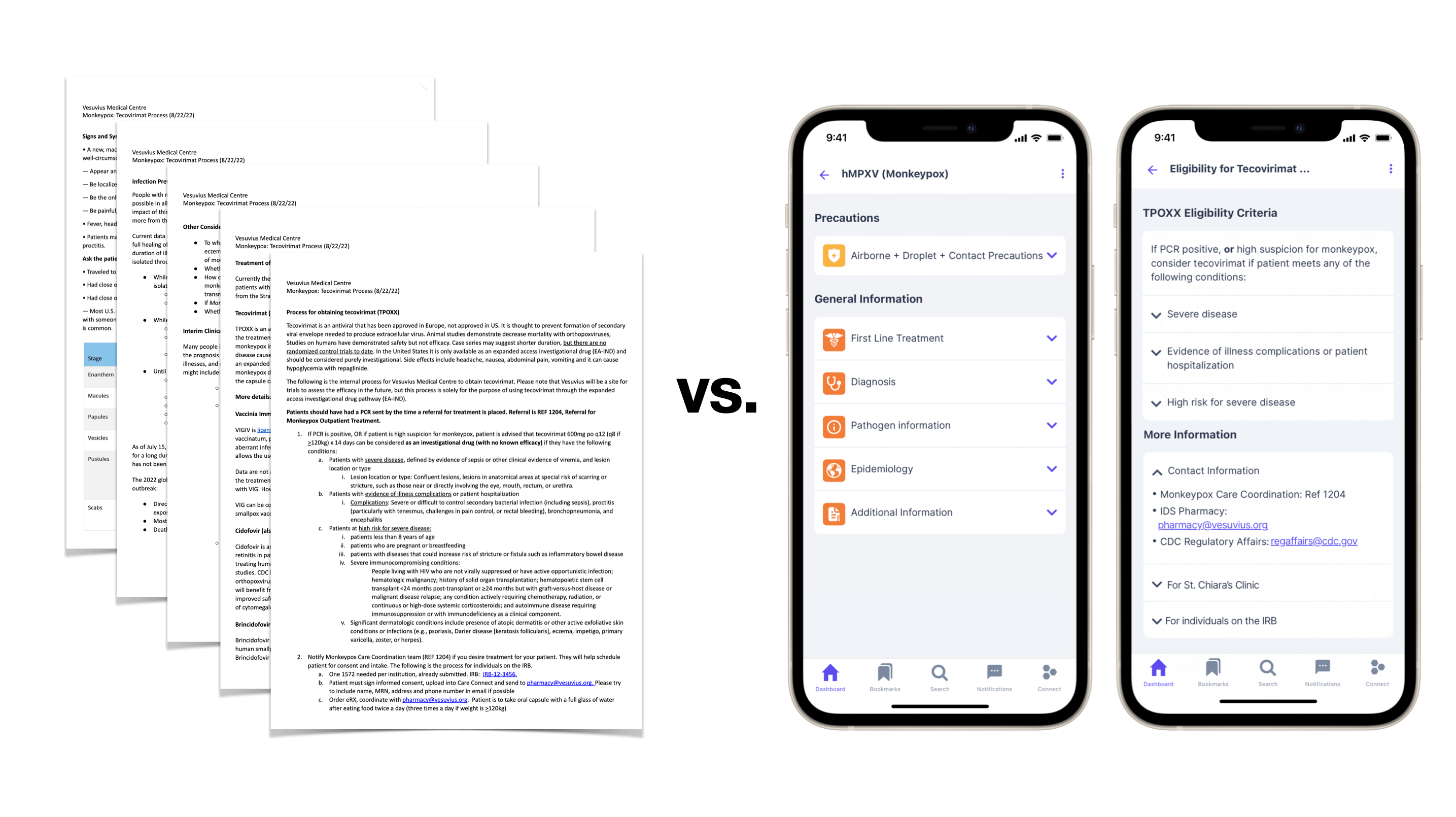Teams of infectious disease experts at the global and national levels, such as the WHO, ECDC, and IDSA, set the standards for distilling and disseminating medical research into practice guidance. These expert-led guidelines are usually comprehensive and lengthy written works, which are useful as detailed, evidence-based references but are typically not practical for use in a fast-paced clinical setting. For example, a single guideline can be as long as 250 pages, which is too much information for the overburdened healthcare provider to digest at the point of care.
According to Kyle Massey, Antimicrobial Stewardship Co-Director at Northern Light Eastern Maine Medical Center, an additional challenge is that generic guidelines may not always be relevant when considering local recommendations. “There are many clinical decision resources and knowledge bases available for infectious diseases and antibiotics, and often these are positioned directly in our EHRs. Unfortunately, these resources do not always account for local nuances such as formulary, local antibiograms, or the demographics of your catchment area.”
These challenges are why standard practice guidelines are consistently pared down and transformed into localized clinical pathways for use at the point of care. Clinical pathways, or care pathways, translate practice guidelines and medical literature such as systematic reviews into recommendations and clinical processes for managing specific medical conditions. They take into account the local setting and the unique culture and environment of the healthcare organization. These pathways aim to reduce variations in practice, improve interdisciplinary cooperation, and maximize clinical efficiency and patient safety.

Pillars of Information Design
There are three pillars of information design that Firstline uses when transforming guidance into clinical pathways. Those pillars are Crystallization, Standardization, and Localization.
Crystallization refers to the process of creating pathways that contain just the right amount of information. In our experience, it is usually less than you think. At the point of care, providers are most likely interested in quick access to specific guidance on diagnosis, treatment, or followup. Our team strives to remove any extraneous information that might encumber this workflow.
Standardization refers to the creation of a design system that specifies how colours, icons, fonts, layouts, and other interface elements are to be used. Consistently formatted pathways will be much easier for providers to understand at a glance. “The use of space, formatting, and hierarchy are essential in ensuring an organized, logical flow of information. The way you lay out content is critical to how a user will move through it and identify relevant information,” says Chiara-lyse Lee, Senior Content Manager at Firstline.
A clinical pathway may contain many categories of information, such as etiology, diagnosis, and treatment. To help providers locate their desired information quickly, the Firstline design team has developed a standardized design system, such as an Rx icon for medications, a pathogen icon for causative organisms, and a red cell with a caution triangle for warnings.
The challenge was to make these designs and icons attention-grabbing, universally intuitive, and consistent in their messaging. Chiara-lyse shares from experience, “If there is something that you don’t want a provider to miss, you need to promote that information in the layout and make it extremely clear with formatting. That’s not only a function of the visual design, but it also stems from our qualitative assessment of the information, and the resulting information design we apply.”
Localization refers to the process of adapting generic guidelines to reflect regional susceptibilities, patient populations, drug availability, diagnostic methods, and so on. In fact, the more local your clinical pathways are, the more useful they will be to your providers. Organizations often add things like local contact numbers, drug costs, and institutional branding. These small customizations will increase trust and provide a better end-user experience.
"We need to stop thinking of guidelines as flat, text documents resembling journal articles. Outside of medicine, people are used to information being organized, searchable, integrated and mobile. This is our vision for the design and delivery of medical guidelines as well." - Michael Long, Chief Clinical Officer at Firstline
Improving Accessibility via Mobile
To further improve accessibility, Firstline delivers clinical pathways on a mobile platform, making them easy to reference at the point of care. A seemingly simple process, but for antimicrobial stewards like Kyle, it can transform the way they work. “Unlike Field of Dreams, just because we build it does not mean they’ll come… Firstline plays an important role here by allowing us to meet our prescribers, pharmacists, nurses, and other clinical staff where they are. Specifically, by providing a knowledge base platform that can be accessed online and at the bedside via mobile phone.”
Information also needs to be integrated, dynamic, and mobile to suit the needs of a busy medical setting. Justin Kosar, stewardship lead from Saskatchewan, had this in mind while working with Firstline to develop their mobile clinical pathways. “We very purposely developed ours to stick to a ‘four and six click rule’, so you should be able to get 90%-95% of information within four to six clicks.” Emphasizing just how important speed is, Justin continues, “we know that the average interaction time is about 28 seconds on [our version of Firstline]… and never more than two and a half minutes. That’s not long at all and, for us, that is a huge success.”
For providers in rural areas or low to middle income countries, availability or cost of internet can also be a challenge. Dr. Kelechi Eguzo, President of Marjorie Bash Foundation, points out “We had concerns about the cost of internet data in Nigeria, so it was important that the Firstline app is available offline.” By delivering guidance through a mobile platform that requires limited internet connectivity, Firstline ensures equitable access of information for developing nations at the point of care.
The continued fight against Antimicrobial Resistance
Firstline’s innovative design and delivery of clinical pathways help ID teams improve prescribing behaviour and patient outcomes. The continuous development of tools and features on our mobile platform is largely guided by clinical experts we collaborate with. In this relationship, Firstline contributes its technology and information design expertise to meet the needs of those experts and the many providers that they support. Join us and other AMR advocates in continuing the fight against Antimicrobial Resistance.
